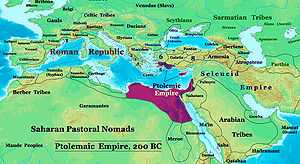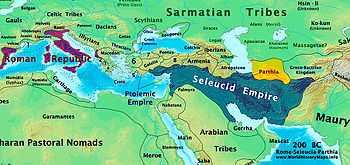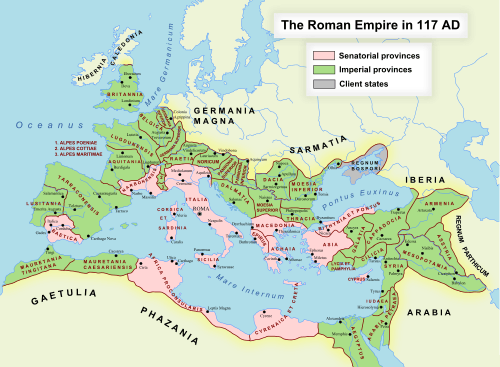Coele-Syria
| Coele-Syria | |||||
| Region of Macedonian Empire / Ptolemaic Kingdom / Seleucid Kingdom | |||||
| |||||
| Historical era | Hellenistic era | ||||
| - | Conquests of Alexander the Great | 332 BC | |||
| - | Hasmonean Revolt, Conquests of Pompey | 64 BC | |||
Koile Syria (Ancient Greek: Κοίλη Συρία), or Cœle-Syria, Cæle-Syria or Celesyria, was a Hellenistic term for a region of Syria. It is widely accepted that the term Coele is a transcription of Aramaic kul, meaning "all, the entire", such that the term originally identified all of Syria.[1][2][3] The word "Coele", which literally means "hollow" in Koine Greek, is thought to have come about via a folk etymology referring to the "hollow" Beqaa Valley between Mount Lebanon and the Anti-Lebanon mountains.[3] The term was commonly used in this wider sense to indicate "all Syria" or "all Syria except Phoenicia", by the writers; Polybius, Pliny, Arrian, Ptolemy[4] and also Diodorus Siculus,[5] who indicated Coele-Syria to stretch as far south as Joppa.
The first and only official use of the term was during the period of Seleucid rule of the region, between c. 200 BCE and 64 BCE. During this period, the term "Coele Syria and Phoenicia" or "Coele Syria" was also used in a narrower sense to refer to the former Ptolemaic territory which the Seleucids controlled, being the area south of the river Eleutherus. This usage was adopted by Strabo and the Books of the Maccabees. However, some Greek writers such as Polemon of Athens and Pausanias[6][7][8] used the term Palestine to refer to the region during this period, which was a term originally given c.450 BCE by Herodotus. Circa 350 CE, Eunapius wrote that the capital of Coele-Syria was the Seleucid city of Antioch, which is North of the Eleutherus.[9]
First known official usage
According to Polybius, a former officer of the Ptolemaic Empire named Ptolemy Thrasea, having fought in the 217 BC Battle of Raphia, defected to the Seleucid king Antiochus III the Great. Antiochus gave him the title "Strategos and Archiereus of Coele-Syria and Phoenicia". Some scholars speculate that this title may have been used previously by the Ptolemies, but no direct evidence exists to support this.[3]
Syrian Wars

The region was disputed between the Seleucid dynasty and the Ptolemaic dynasty during the Syrian Wars. Alexander the Great's general Ptolemy first occupied Coele-Syria in 318 BC. However, when Ptolemy joined the coalition against Antigonus I Monophthalmus in 313 BC, he quickly withdrew from Coele-Syria. In 312 BC Seleucus I Nicator, defeated Demetrius, the son of Antigonus, in the Battle of Gaza which again allowed Ptolemy to occupy Coele-Syria. Though he was again to pull out after only a few months, after Demetrius had won a battle over his general and Antigonus entered Syria in force up to Antigonuses, this brief success had enabled Seleucus to make a dash for Babylonia which Seleucus secured. In 302 BC, Ptolemy joined a new coalition against Antigonus and reoccupied Coele-Syria, but quickly withdrew on hearing a false report that Antigonus had won a victory. He was only to return when Antigonus had been defeated at Ipsus in 301 BC. Coele-Syria was assigned to Seleucus, by the victors of Ipsus, as Ptolemy had added nothing to the victory. Though, given Ptolemy's track record, he was unlikely to organize a serious defense of Coele-Syria, Seleucus acquiesced in Ptolemy's occupation, probably because Seleucus remembered how it had been with Ptolemy's help he had reestablished himself in Babylonia.
The later Seleucids were not to be so understanding, resulting in the century of Syrian Wars between the Ptolemies and Seleucids. The Battle of Panium in 200 BC, during the Fifth Syrian War, was the final decisive battle between the two sides in ending Ptolemaic control over the region. The 171–168 BC conflicts over Coele-Syria, between Antiochus IV Epiphanes and Ptolemy VI Philometor, are discussed in Livy’s The History of Rome from its Foundation (in XLII. 29 and XLV. 11–12).
Seleucid control over the area of Judea began diminishing with the eruption of the Maccabean Revolt in 165 BC. With Seleucid troops being involved in warfare on the Parthian front, Judea succeeded in securing its independence by 140 BC. Despite attempts of Seleucid rulers to regain territories, the conquests of Pompey in 64 BC were a decisive blow to them, and Syria became part of the Roman Republic.
Upper Syria

Under the Macedonian kings, Upper Syria (Syria Superior) was divided into four parts (tetrarchies) which were named after their capitals;[10]
Under the Romans, the province was divided into nine districts: Cassiotis, Apamene, Chalcidice, Seleucis, Pieria, Commagene, Cyrrhestice, Chalybonitis, Palmyrene.
Nomenclatures of Syria
Nomenclatures of Syria given in the time of Cyrus the Great c.530 BCE Primary Kul Eber-Nari All Across-the-River Alternate Koile Syria Corrupt Greek translation - Wars over Coele-Syria given by Polybius c.150 BCE[11]
- I shall tell how Antiochus (Antiochus III the Great) and Ptolemy Philopator (Ptolemy IV Philopator) first quarreled and finally went to war with each other for the possession of Coele-Syria. (Syrian Wars 219–217 BCE) [...] (Now I come to) the disturbances in Egypt; (The attempted partition of the dominions of Ptolemy V Epiphanes c.204) how, after the death of King Ptolemy (IV), Antiochus and Philip (Philip V of Macedon) entered into a compact for the partition of the dominions of that monarch's infant son, I shall describe their treacherous dealings. Philip laying hands upon; the islands of the Aegean and Caria and Samos. Antiochus upon; Coele-Syria and Phoenicia.[12]
- Boundaries of Egypt given by Diodorus Siculus c.50 BCE[13]
- Having spoken of the three boundaries of Egypt, by which it is distinguished from the rest of the continent, we now proceed to the next. The fourth side is nearly surrounded with a vast sea, without any harbours, being a very long and tedious voyage, and very difficult to find any place of landing. For from Parcetonium in Africa, to Joppa in Cœlo-Syria, for the space almost of five thousand furlongs, there is not one safe harbour to be found, except Pharus.[14]
Nomenclatures of Syria given by Strabo c.30 BCE[15] Primary Cœlê-Syria & Seleucis-Syria & Phœnicia &c. &c. Cœlê-Syria ≠ Cœlo-Syrians Alternate Cœlo-Syrians & Syrians & Phœnicians Similar to nomenclature given by Herodotus Nomenclatures of Syria given by Pliny the Elder c.78 CE[16] Primary Syria deprecated terms: Palæstina, Judæa, Cœle, Phœnice Alternate Syria & Phœnice - Towns in Coelesyria given by Ptolemy c.150 CE[17][18]
- Heliopolis
- Abila which is called Lysinia (Abila Lysanios)
- Saana
- Ina
- Samulis (Samoulis)
- Abida
- Capitolias
- Adra
- Canatha
Nomenclature of Syria given in the time of Septimius Severus c.200 CE[19][20] Syria Coele Provincia Syria Coele Syria Coele ≠ Cœlê-Syria ≠ Cœlo-Syrians Phoenice Provincia Syria Phoenice Syria Palaestina Provincia Syria Palæstina Arabia Provincia Arabia Petraea
- Capital of the Seleucid Empire was Antioch (240–63 BCE)
- Capital of the Syria Coele (Roman province) was Antioch (200–600 CE)
Eunapius, a historian of the 4th century (c.350 CE), in writing Lives of Philosophers and Sophists, likely used the nomenclature of Syria given in the time of Septimius Severus, when he wrote, 'Libanius was born at Antioch, the capital of Coele Syria as it is called. This city was founded by Seleucus surnamed Nicator'.[21]
- ↑ , "La Syrie creuse n'existe pas", in G. L. Gatier, et al. Géographie historique au proche-orient (1988:15-40), reviving the explanation offered by A. Schalit (1954), is reported by Robin Lane Fox, Travelling Heroes in the Epic Age of Homer (2008, notes p378f): "the crux is solved".
- ↑ The Hellenistic Settlements in Syria, the Red Sea Basin, and North Africa, Getzel M. Cohen, 2006 and pdf here
- ↑ 3.0 3.1 3.2 A History of the Jews and Judaism in the Second Temple Period, Volume 2, Lester L. Grabbe, p173 "Yet the suggestion is widely accepted that the name actually derives from Aramaic for "all Syria", which was then assimilated by the Greeks to a more usual pattern for place names"
- ↑ From Sartre, pages 21-25: Diodorus 18.6.3, 61.4; 20.73.2; Polybius 8.17.10–11; Pliny, Naturalis Historiæ 5.106–10; Arrian Anabasis 2.13.7; Ptolemy 5.14.1.
- ↑ Diodorus Siculus c.150 BCE, Bibliotheca historica, XIX, 93; XXIX, 29
- ↑ Studies in Josephus and the varieties of ancient Judaism: Louis H. Feldman. Books.google.co.uk. Retrieved 2011-12-11.
- ↑ "Pausanias, Description of Greece, 9. 1 - 22". Theoi.com. Retrieved 2011-12-11.
- ↑ Parke, Herbert William. Sibyls and sibylline prophecy in classical antiquity. Books.google.co.uk. Retrieved 2012-05-28.
- ↑ Eunapius, Lives of the Philosophers and Sophists
- ↑ Society for the Diffusion of Useful Knowledge (Great Britain) (1842). Penny cyclopaedia of the Society for the diffusion of useful knowledge. C. Knight. pp. 476–.
Antient Divisions of Syria. –Under the Macedonian kings Syria was divided into four parts (tetrarchies), which were named after their capitals, Antioch, Seleuceia, Apamea, and Laodicea. Both the Greeks and the Romans called the northern portion of Syria, that is the whole country with the exception of Coele-Syria, Phoenice, and Palestine, by the name of Upper Syria (???, Syria Superior), to distinguish it from Coele Syria (???, that is, the Hollow Syria), which was the name given to the valley between the ridges of Libanus and Anti Libanus. Under the Romans the province was divided into nine districts: Cassiotis, Apamene, Chalcidice, Seleucis, Pieria, Commagene, Cyrrhestice, Chalybonitis, Palmyrene.(Image of p. 476 at Google Books)
- ↑ Polybius c.150 BCE, The Histories, Book 3, Chapter 2
- ↑ Shuckburgh, Evelyn. "Polybius, Histories". Follow PerseusDigLib on Twitter Perseus Digital Library. Tufts University. Retrieved 28 January 2015.
- ↑ Diodorus of Sicily, with an English translation by C.H. Oldfather
- ↑ Diodorus (Siculus.) (1814). The Historical Library of Diodorus the Sicilian: In Fifteen Books. To which are Added the Fragments of Diodorus, and Those Published by H. Valesius, I. Rhodomannus, and F. Ursinus. W. MʻDowall. pp. 36–.
Image of p. 36 at Google Books
- ↑ Strabo 16.2, Geographica
- ↑ Crane, Gregory. "Pliny the Elder, The Natural History John Bostock, M.D., F.R.S., H.T. Riley, Esq., B.A., Ed.". Perseus Digital Library. Retrieved 25 January 2015.
Plin. Nat. 5.13, CHAP. 13. (12.)—SYRIA.
- ↑ Claudius Ptolemy c.150 CE, The Geography, Book 5, Chapter XIV. Location of Syria (Fourth map of Asia)
- ↑ Crane, Gregory. "Dictionary of Greek and Roman Geography (1854) William Smith, LLD, Ed.". Perseus Digital Library. Tufts University. Retrieved 27 January 2015.
- ↑ Raleigh, Walter (1829). The Works of Sir Walter Ralegh, Kt: The history of the world. The University Press. pp. 217–. 3vGAz5Gs3JEC.
In Syria, taken largely, there were many small provinces as Coelesyria, which the Latins call Syria Cava, because it lay in that fruitful valley between the mountains of Libanus and Anti-Libanus, in which the famous cities of Antioch, Laodicea, Apamea, with many others were seated. (Raleigh 1829, p. 217, at Google Books)
- ↑ Lendering, Jona. "Provinces (Roman)". Livius. Livius.org. Retrieved 26 January 2015.
- ↑ Pearse, Roger. "Eunapius, Lives of the Philosophers and Sophists (1921) pp.343-565. English translation". Early Church Fathers - Additional Texts. tertullian.org. Retrieved 19 December 2014.
Libanius was born at Antioch, the capital of Coele Syria as it is called. This city was founded by Seleucus surnamed Nicator
See also
- Hasmonean kingdom
- Roman Syria
- Herodian kingdom
- Tetrarchy (Judea)
- Judaea (Roman province)
- Syria Palaestina
Notes
External links
- Bagnall, R., J. Drinkwater, A. Esmonde-Cleary, W. Harris, R. Knapp, S. Mitchell, S. Parker, C. Wells, J. Wilkes, R. Talbert, M. E. Downs, M. Joann McDaniel, B. Z. Lund, T. Elliott, S. Gillies. "Places: 991407 (Syria Coele)". Pleiades. Retrieved March 8, 2012.





